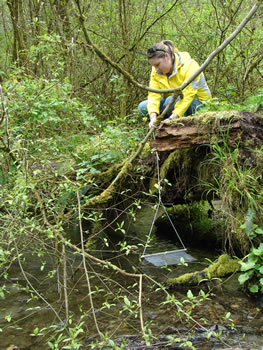Stream monitoring for early detection of invasive Phytophthora species in Western Washington
The Phytophthora stream monitoring program at WSU Puyallup
In this project, we are involved with
|

2017-2018 Monitoring for Phytophthora in restoration sites in Pierce County, WA 2015 Stream monitoring in the Northern Olympic Peninsula and urban areas 2011 Stream monitoring in Puget Sound 2010 Stream monitoring pilot study
What is Phytophthora?
Invasive Phytophthora species
One way to stop the damage an invasive species such as Phytophthora may inflict on an ecosystem is to control or eliminate the species when its populations are still small. Students and other volunteers can help scientists by conducting early detection surveys. Unlike many well-known invasive species, Phytophthoras are microscopic and must be detected by indirect methods, such as baiting with leaves of susceptible plant hosts. Stream monitoring programs have been shown to be an effective approach to detect the spread of P. ramorum and focus eradication efforts to high risk areas, thus reducing the threat this pathogen poses to our landscape and forest ecosystems. |
|
How to get involved We are looking for volunteer groups, students, or other people who are interested in helping monitor streams in Western Washington for P. ramorum and other Phytophthora species. We need people who can access selected streams and place bait bags or collect water samples at regular intervals and can return these samples to the lab. If you are interested in participating, let us know.
|
 |
For more information or if you wish to be added to the mailing list, contact Marianne Elliott
Our Cooperators:
USDA is an equal opportunity provider and employer.


